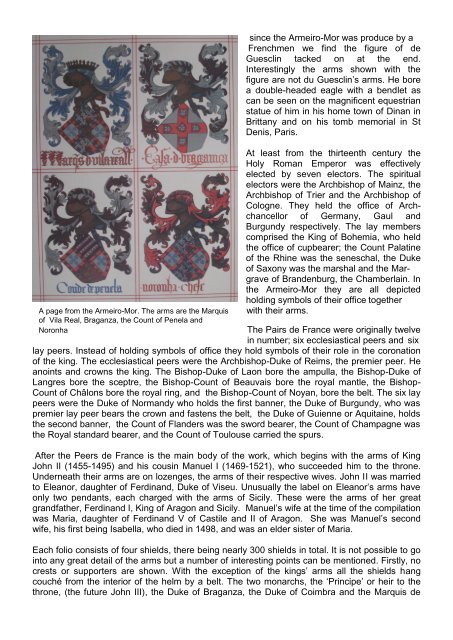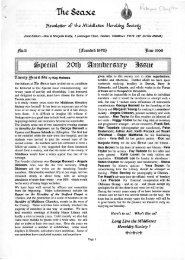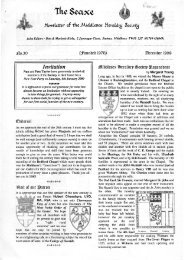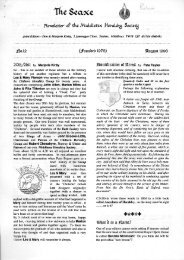No.57 - Middlesex Heraldry Society
No.57 - Middlesex Heraldry Society
No.57 - Middlesex Heraldry Society
You also want an ePaper? Increase the reach of your titles
YUMPU automatically turns print PDFs into web optimized ePapers that Google loves.
since the Armeiro-Mor was produce by a<br />
Frenchmen we find the figure of de<br />
Guesclin tacked on at the end.<br />
Interestingly the arms shown with the<br />
figure are not du Guesclin‟s arms. He bore<br />
a double-headed eagle with a bendlet as<br />
can be seen on the magnificent equestrian<br />
statue of him in his home town of Dinan in<br />
Brittany and on his tomb memorial in St<br />
Denis, Paris.<br />
At least from the thirteenth century the<br />
Holy Roman Emperor was effectively<br />
elected by seven electors. The spiritual<br />
electors were the Archbishop of Mainz, the<br />
Archbishop of Trier and the Archbishop of<br />
Cologne. They held the office of Archchancellor<br />
of Germany, Gaul and<br />
Burgundy respectively. The lay members<br />
comprised the King of Bohemia, who held<br />
the office of cupbearer; the Count Palatine<br />
of the Rhine was the seneschal, the Duke<br />
of Saxony was the marshal and the Mar-<br />
grave of Brandenburg, the Chamberlain. In<br />
the Armeiro-Mor they are all depicted<br />
holding symbols of their office together<br />
A page from the Armeiro-Mor. The arms are the Marquis with their arms.<br />
of Vila Real, Braganza, the Count of Penela and<br />
Noronha The Pairs de France were originally twelve<br />
in number; six ecclesiastical peers and six<br />
lay peers. Instead of holding symbols of office they hold symbols of their role in the coronation<br />
of the king. The ecclesiastical peers were the Archbishop-Duke of Reims, the premier peer. He<br />
anoints and crowns the king. The Bishop-Duke of Laon bore the ampulla, the Bishop-Duke of<br />
Langres bore the sceptre, the Bishop-Count of Beauvais bore the royal mantle, the Bishop-<br />
Count of Châlons bore the royal ring, and the Bishop-Count of Noyan, bore the belt. The six lay<br />
peers were the Duke of Normandy who holds the first banner, the Duke of Burgundy, who was<br />
premier lay peer bears the crown and fastens the belt, the Duke of Guienne or Aquitaine, holds<br />
the second banner, the Count of Flanders was the sword bearer, the Count of Champagne was<br />
the Royal standard bearer, and the Count of Toulouse carried the spurs.<br />
After the Peers de France is the main body of the work, which begins with the arms of King<br />
John II (1455-1495) and his cousin Manuel I (1469-1521), who succeeded him to the throne.<br />
Underneath their arms are on lozenges, the arms of their respective wives. John II was married<br />
to Eleanor, daughter of Ferdinand, Duke of Viseu. Unusually the label on Eleanor‟s arms have<br />
only two pendants, each charged with the arms of Sicily. These were the arms of her great<br />
grandfather, Ferdinand I, King of Aragon and Sicily. Manuel‟s wife at the time of the compilation<br />
was Maria, daughter of Ferdinand V of Castile and II of Aragon. She was Manuel‟s second<br />
wife, his first being Isabella, who died in 1498, and was an elder sister of Maria.<br />
Each folio consists of four shields, there being nearly 300 shields in total. It is not possible to go<br />
into any great detail of the arms but a number of interesting points can be mentioned. Firstly, no<br />
crests or supporters are shown. With the exception of the kings‟ arms all the shields hang<br />
couché from the interior of the helm by a belt. The two monarchs, the „Principe‟ or heir to the<br />
throne, (the future John III), the Duke of Braganza, the Duke of Coimbra and the Marquis de














